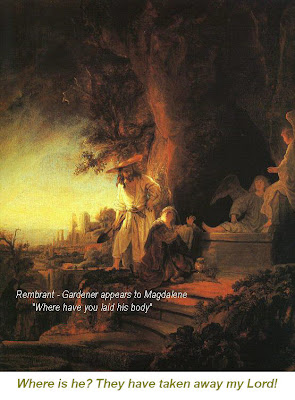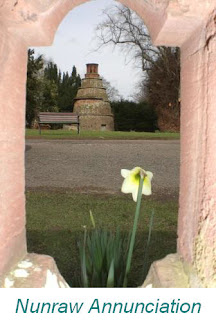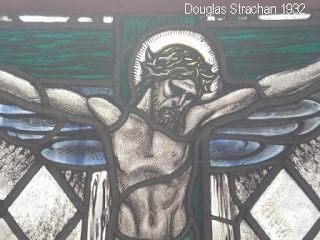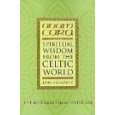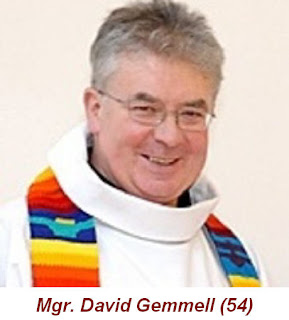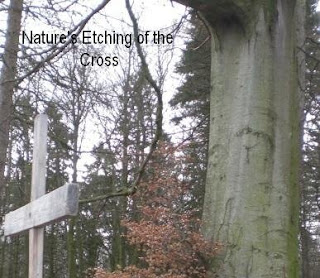
Annual Parish Pilgrimage for Lent.
9th March 2008 Parishioners from Roswell, Bonnyrigg and Gorebridge made their Annual Way of the Cross for Lent at Nunraw. They came well clad for the open air procession trek on the south avenue from the Guest-house to the abbey. As they passed the farm animals seemed as much interested in the people as much as the people were interested in them – distraction from devotion or love of the Lord’s creatures? We credit the establishment of the outdoor Stations of the Cross to the members of these parishes. They began this Lenten practice at first by simple choosing their own locations along the route. Later the asked to make the Stations more permanent. They commissioned a local blacksmith, different families sponsored each of iron-wrought Crosses, The crosses are simply numbered, 1st to 14th without any figures attached. (A 15th is added painted in gold, looking to the Resurrection). Now Retreatants can also avail of this prayer in motion going up the avenue and on through the farmyard.
The 12th Station
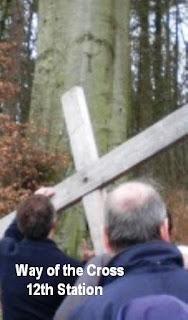 After some years, one of these visitors noticed a strange sight at the 12th Station. Beside this Station of the Crucifixion she notice, on the bulky trunk of the overhanging beech tree some marking on the bark. From the small cross on the road edge, looking at the bowl of the tree there is the distinctive outline of the cross and figure of the Crucified Saviour. It is as if nature has added its own etching to the contribution of the people who set the Crosses.
After some years, one of these visitors noticed a strange sight at the 12th Station. Beside this Station of the Crucifixion she notice, on the bulky trunk of the overhanging beech tree some marking on the bark. From the small cross on the road edge, looking at the bowl of the tree there is the distinctive outline of the cross and figure of the Crucified Saviour. It is as if nature has added its own etching to the contribution of the people who set the Crosses.
The procession then continues on the Abbey for monks regular Office of Vespers. It is followed by Benediction of the Blessed Sacrament. Finally the Abbot gives a Lenten talk for reflection.
This year his theme took up the Raising of Lazarus and a moving reflection on the contrast of the role of Martha and Mary. In a surprising way he also followed a Lent journey by seeing a correspondence of this story with the EIGHTH WORD of the Cross, as he called it.
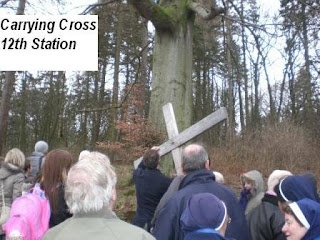
Talk by Abbot Raymond
He Wants to See You.
The raising of Lazarus from the dead is perhaps the climax of all Jesus’ healing miracles. It comes at the climax of his public life; it is the most dramatically performed of them all – we might even call it the most theatrical, with all the crowds gathered round and the sisters in tears and even Jesus himself weeping and groaning. Then the command to remove the stone; then the loud cry: “Lazarus, come forth” and so on. But for me there has always been one little detail in that story, a detail I have never understood, yet it always strikes me as very strange and very significant. Why did Mary stay at home when Martha ran to meet Jesus? Why did Jesus have to send Martha back to tell her that he wanted to see her?
When he did arrive, eventually, four days after Lazarus had been laid in the tomb, it was Martha, as we have been considering, who ran to meet him. Mary stayed on at home. Why? We might have thought that Mary, being the personification of the contemplative soul, the one whose love prompted her to anoint the Lord’s feet with precious ointment and wipe his feet with her hair; surely she would be the most eager to run to meet him. But no, it was Martha who ran first. Not that Martha’s first words to Jesus were any different from those of Mary when she did come: “If you had been here, my brother wouldn’t have died.” So we are left with the puzzle: Why did Mary stay at home?
We might understand Mary’s behaviour if we consider her as being the more contemplative and introvert of the two sisters. Perhaps therefore, although she might feel the grief more keenly, yet she was more able to support it and bear it with her own inner strength. Martha, on the other hand was more extrovert; she wore hear heart on her sleeve. If she was angry she just had to show it: “Tell my sister to help me instead of just sitting there!” If she was heartbroken and uncomprehending she just had to run and tell the Lord. “If only you had been here my brother would not have died!”
Surely there is a deep meaning in all this. Surely God has something important to teach us in this. In the first Martha-Mary story it is Mary who comes out tops. She is the one who chose the better part, but in this story it is Martha who shines, she knows what to do. The lesson Jesus wants to convey is seen best in Martha and, as in the first story, it is precisely the contrast between the behaviour of the two which brings out the lesson.
From this point of view the climax of the story, the punch line of the lesson, is contained in the words of Jesus to Martha when he tells her to call Mary because he wants to see her. “Jesus is here and He wants to see you!” Martha told her. From these words Mary learns that no matter how heroic and accepting she is of Lazarus death, Jesus wants her to understand that it is better for her to give full human expression to her grief. She is not an angel, but a human being of flesh and blood. There are times when we must wear our hearts on our sleeves and give full expression to our grief before the Lord. He doesn’t mind if we let him know how hurt we are. It brings us closer to him. He doesn’t mind if we complain and ask him why this has to be.
This lovely little story is Jesus’ way of saying to Mary and to us all: “There are times when you mustn’t hide your feelings from me; no more than you would hide them from your dearest friend on earth. In the first Martha-Mary story it was Mary who chose the better part, but in this story it is obviously Martha who chose the better part. In the first story it was Mary who best understood the heart of the Master; in the second story it was Martha who best understood the heart of the Master.
Let us wear our hearts on our sleeves. This wearing of our heart in our sleeve also comes into our Lent as we come near Holy week. It can be seen in another story. It is one of the last words of Jesus corresponding to telling Mary ‘COME’. We know of the SEVEN Words on the Cross but there was another saying, just before he went to the Cross. He turned to the women of Jerusalem and he said, “Weep not for me, weep for yourselves and your children”. Did he mean that? Don’t week for me. There is a tremendous lesson in that.
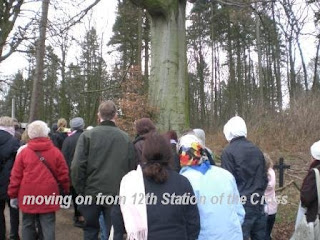 Compassion in the Passion.
Compassion in the Passion.
Eighth Last Words
We often speak of the Seven Last words of Jesus; the last words he spoke while hanging on the Cross:
1. “Woman, behold your Son” “Behold your Mother”
2 Father, forgive them. They know not what they do”
3 “This day you will be with me in Paradise
4 “My God! My God! Why have you forsaken me?”
5 “I thirst!”
6 “It is accomplished”
7 “Father, into your hands I commend my Spirit.”
However we might add an eighth last saying; one pronounced, not while hanging from the cross, but while on his way to the Cross. The words he spoke to the women of Jerusalem: “Weep not for me, but for yourselves and for your children.”
These words say so much about the mystery of the cross and, in their own way are a complete description of the mind and heart of Christ in his passion.
As we look on him hanging on the Cross we should see, not just the sufferings of Christ alone, but, in him, the sufferings of the whole human race from Adam to Eternity. The nails are not just in the hands and feet of the Saviour, but in the hands and feet of all suffering humanity.
Don’t weep for me but for yourselves and for your children, he said. There must be some tremendous lesson in that. I think it is this that is the lesson, and it is very closely related to the story we have of Mary and Martha.
He is saying, “I am going to hang on the cross for you and yet the nails in my hands and feet are not really in MY hands and feet. The nails are in your hands and feet, in the hands and feet of your children. It is not my cross. It is your cross, down all the centuries. So he sees the suffering of all his children. And he had to take in that. So his Passion and the suffering was not so much FOR us as WITH us. And he wants us to weep for each other, not so much for Christ as for all those who suffering. It is their cross. Jesus could have loosened himself from the cross and come down.. But you and I can’t. --- and that of the children and the sons of men. We cannot escape it. We might struggle against it, may fight against it but the nails will only tear us the more.
Jesus knows this. Because he wants our compassion to reach out through all our brothers and sisters. And in the past, and in the future and in the resent.
“Weep not for me but for yourselves and your children”, and let me see that weeping, that it be a weeping of compassion, as my Passion was the suffering of compassion.
Our Faith is a Faith of joy indeed, but as long as this world is so full of sadness and suffering, then a sense of compassion can never be far from our minds. And this is not a compassion that dampens our joy, but one which keeps it peacefully in due proportion.
When Jesus said: “Weep not for me, but for yourselves and for your children”, he really meant it. Let us learn to respect the sincerity of his words and take them really at their face value.
_____________________
They are enterprising and their apostolate is often marked by an originality, by a genius that demands admiration. They are generous: often they are found at the outposts of the mission, and they take the greatest of risks for their health and their very lives. Truly the Church owes them much” (Apostolic Exhortation Evangelii Nuntiandi, 69).

